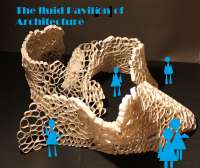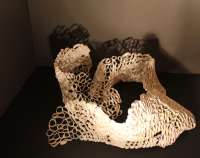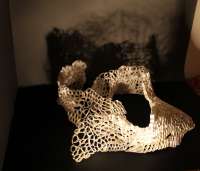The fluid pavilion of architecture is a model for expression in contemporary aesthetics. It’s a conceptual model based on the theories of Deleuze about Leibniz and Baroque. The Baroque endlessly produces folds.
Deleuze writes: We can better understand in what way the Baroque is a transition. Classical reason toppled under the force of divergences, incompossibilities, discords, dissonances. But the Baroque represents the ultimate attempt to reconstitute a classical reason by dividing divergences into as many worlds as possible, and by making from incompossibilities as many possible borders between worlds. (81) Deleuze, Gilles. The Fold: Leibniz and the Baroque. Trans. Tom Conley, London: Athlone Press, 1993.
Walls are made from only a single sheet of canvas with staples, looking like large - scale organic - installation. The form consists of a series of stapled folds of canvas, fold over fold, one upon the other, develops infinite possibilities with rounded edges, that mirror the surrounding topography to become a non - stop fluid passage between inside and outside, real and unreal, natural and man-made, theoretical and practical themes. That transition can be understood as a whole bodily experience that takes into account not only space but psychical matters. It’s an abstract model that helps us read life as an ongoing project. Folds create infinite possibilities of shapes and shadows, infinite possibilities of creation. Deleuze supports that Leibniz is the first great philosopher and mathematician of the pleat, of curves and twisting surfaces.
The fluid pavilion of architecture is a model for expression in contemporary aesthetics. It’s a conceptual model based on the theories of Deleuze about Leibniz and Baroque. The Baroque endlessly produces folds.
Deleuze writes: We can better understand in what way the Baroque is a transition. Classical reason toppled under the force of divergences, incompossibilities, discords, dissonances. But the Baroque represents the ultimate attempt to reconstitute a classical reason by dividing divergences into as many worlds as possible, and by making from incompossibilities as many possible borders between worlds. (81) Deleuze, Gilles. The Fold: Leibniz and the Baroque. Trans. Tom Conley, London: Athlone Press, 1993.
Walls are made from only a single sheet of canvas with staples, looking like large - scale organic - installation. The form consists of a series of stapled folds of canvas, fold over fold, one upon the other, develops infinite possibilities with rounded edges, that mirror the surrounding topography to become a non - stop fluid passage between inside and outside, real and unreal, natural and man-made, theoretical and practical themes. That transition can be understood as a whole bodily experience that takes into account not only space but psychical matters. It’s an abstract model that helps us read life as an ongoing project. Folds create infinite possibilities of shapes and shadows, infinite possibilities of creation. Deleuze supports that Leibniz is the first great philosopher and mathematician of the pleat, of curves and twisting surfaces.


